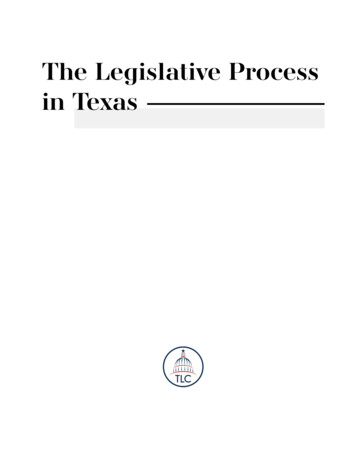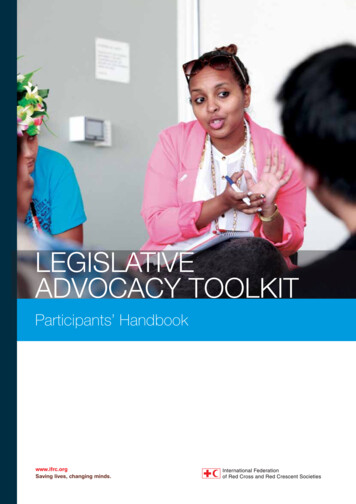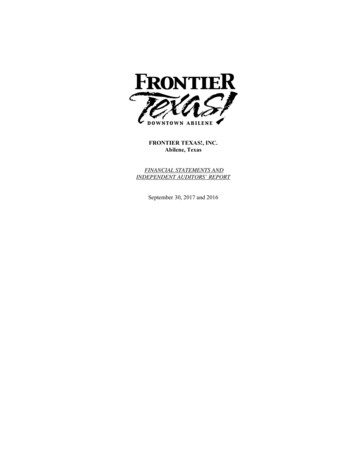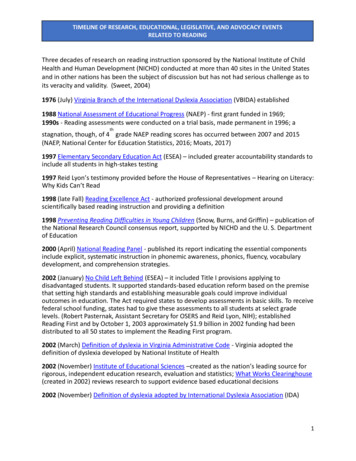
Transcription
The Legislative Processin Texas
The Legislative Processin TexasPublished by the Texas Legislative CouncilFebruary 2021
Texas Legislative CouncilLieutenant Governor Dan Patrick, Joint ChairSpeaker Dade Phelan, Joint ChairJeff Archer, Executive DirectorThe mission of the Texas Legislative Council isto provide professional, nonpartisan service and supportto the Texas Legislature and legislative agencies.In every area of responsibility,we strive for quality and efficiency.During previous legislative sessions, the information in this publication was published as part ofthe Guide to Texas Legislative Information.Copies of this publication have been distributed in compliance with the state depository law(Subchapter G, Chapter 441, Government Code) and are available for public use through theTexas State Publications Depository Program at the Texas State Library and other state depositorylibraries. This publication can be found at https://www.tlc.texas.gov/publications.Additional copies of this publication may be obtained from the council:By mail: P.O. Box 12128, Austin, TX 78711-2128By phone: (512) 463-1144By e-mail: house.documentdistribution@tlc.texas.govBy online request form (legislative offices only): https://bilreq/House.aspxIf you have questions or comments regarding this publication, please contact Kellie Smith byphone at (512) 463-1155 or by e-mail at kellie.smith@tlc.texas.gov.
Table of ContentsHOW A BILL ORIGINATES . . . . . . . . . . . . . . . . . . . . . . . . . . . . . . . . . . . . . . . . . . . . . . . . . . . . . . . . . . . . . . . . . . . . 1INTRODUCING A BILL . . . . . . . . . . . . . . . . . . . . . . . . . . . . . . . . . . . . . . . . . . . . . . . . . . . . . . . . . . . . . . . . . . . . . . . 1THE ROLE OF COMMITTEES. . . . . . . . . . . . . . . . . . . . . . . . . . . . . . . . . . . . . . . . . . . . . . . . . . . . . . . . . . . . . . . . . . 2REFERRAL TO A COMMITTEE. . . . . . . . . . . . . . . . . . . . . . . . . . . . . . . . . . . . . . . . . . . . . . . . . . . . . . . . . . . . . . . . . 2COMMITTEE MEETINGS. . . . . . . . . . . . . . . . . . . . . . . . . . . . . . . . . . . . . . . . . . . . . . . . . . . . . . . . . . . . . . . . . . . . . 2COMMITTEE REPORTS . . . . . . . . . . . . . . . . . . . . . . . . . . . . . . . . . . . . . . . . . . . . . . . . . . . . . . . . . . . . . . . . . . . . . . 3HOUSE CALENDARS AND LIST OF ITEMS ELIGIBLE FOR CONSIDERATION. . . . . . . . . . . . . . . . . . . . . . . . . . . 4SENATE REGULAR ORDER OF BUSINESS AND INTENT CALENDAR . . . . . . . . . . . . . . . . . . . . . . . . . . . . . . . . . 5FLOOR ACTION. . . . . . . . . . . . . . . . . . . . . . . . . . . . . . . . . . . . . . . . . . . . . . . . . . . . . . . . . . . . . . . . . . . . . . . . . . . . . 5CONSIDERATION OF LOCAL AND NONCONTROVERSIAL BILLS . . . . . . . . . . . . . . . . . . . . . . . . . . . . . . . . . . . . 6RETURN OF A BILL TO THE ORIGINATING CHAMBER . . . . . . . . . . . . . . . . . . . . . . . . . . . . . . . . . . . . . . . . . . . . 6CONFERENCE COMMITTEE . . . . . . . . . . . . . . . . . . . . . . . . . . . . . . . . . . . . . . . . . . . . . . . . . . . . . . . . . . . . . . . . . . 6GOVERNOR’S ACTION. . . . . . . . . . . . . . . . . . . . . . . . . . . . . . . . . . . . . . . . . . . . . . . . . . . . . . . . . . . . . . . . . . . . . . . 7EFFECTIVE DATE. . . . . . . . . . . . . . . . . . . . . . . . . . . . . . . . . . . . . . . . . . . . . . . . . . . . . . . . . . . . . . . . . . . . . . . . . . . . 7FILING AND PUBLICATION OF LAWS. . . . . . . . . . . . . . . . . . . . . . . . . . . . . . . . . . . . . . . . . . . . . . . . . . . . . . . . . . . 7OTHER LEGISLATION—RESOLUTIONS . . . . . . . . . . . . . . . . . . . . . . . . . . . . . . . . . . . . . . . . . . . . . . . . . . . . . . . . . 8FLOWCHARTS. . . . . . . . . . . . . . . . . . . . . . . . . . . . . . . . . . . . . . . . . . . . . . . . . . . . . . . . . . . . . . . . . . . . . . . . . . . . . . 9PROCESS FOR SENATE BILLS . . . . . . . . . . . . . . . . . . . . . . . . . . . . . . . . . . . . . . . . . . . . . . . . . . . . . . . . . . . . . 10PROCESS FOR HOUSE BILLS . . . . . . . . . . . . . . . . . . . . . . . . . . . . . . . . . . . . . . . . . . . . . . . . . . . . . . . . . . . . . 12
This page left intentionally blank.
The Legislative Processin TexasThe Texas legislative process is governed by the Texas Constitution and applicable statutes(available on the Texas Constitution and Statutes webpage) and by the rules of procedureof the senate and house of representatives that are adopted at the beginning of a regularsession. This publication provides a general summary of the different phases of the legislativeprocess. The process described specifies “bill,” although resolutions follow similar steps. Seethe subsequent discussion regarding the legislative process for joint resolutions, concurrentresolutions, and simple resolutions for differences specific to those documents.HOW A BILL ORIGINATESThe bill is the most common type of legislative document and is the only means by which a law maybe enacted, amended, or repealed. Only a legislator may introduce a bill into the legislative process, althoughthe idea for a bill may originate from a source other than the legislator, such as an interested outside partyor the findings of a committee study. The text of a bill may be draftedby the legislator personally (see the Texas Legislative Council DraftingOnly a legislator mayManual), by an interested outside party, or, as is often the case, by theintroduce a bill intoprofessional staff of the Texas Legislative Council or another appropriatethe legislative process,legislative entity.INTRODUCING A BILLA bill is first introduced by a legislator in the legislator’s ownchamber, which is considered the bill’s originating chamber. Followingpassage of the bill by that chamber, the bill moves to the oppositechamber for approval before proceeding to the governor. The stepsin a bill’s progress are basically the same in each chamber, with manyopportunities for the amendment or defeat of the bill.1although the idea for abill may originate froma source other than thelegislator, such as aninterested outside partyor the findings of acommittee study.
To introduce a bill, a legislator must file the bill with the chief clerk of the house or the secretaryof the senate, as appropriate. Both the house and senate rules permit unrestricted introduction of bills duringthe first 60 calendar days of a regular session. After the 60-daydeadline, the introduction of any bill, other than a local bill, an.house and senateemergency appropriations bill, or a bill to address emergencyrules permit unrestrictedmatters submitted by the governor, requires the consent of at leastintroduction of bills duringfour-fifths of those representatives present and voting if the billis to be introduced in the house, or the consent of at least fourthe first 60 calendar days offifths of the members of the senate if the bill is to be introduceda regular session.in the senate.THE ROLE OF COMMITTEESThe size of the legislature and the volume of work confronting it each session make lengthy deliberationon all proposed measures by the entire membership a difficult task. For this reason, the basic business in bothchambers is conducted according to the committee system. The creation of committees to consider introducedbills and advise on their disposition is provided for in the rules of each chamber, and committees are formedat the beginning of each regular session. Although nearly all bills are referred to a committee, a large numberof bills are never reported out of committee and are considered to have “died” in committee.For most house committees, membership is determined in part by seniority and in part by appointmentsby the speaker of the house. Each representative sits on at least one committee, while most sit on two or three.For senate committees, membership is determined entirely by appointments by the lieutenant governor, andsenators generally sit on four or five committees.REFERRAL TO A COMMITTEEWhen a bill is introduced or received from the opposite chamber for consideration, it is officially readinto the record, using its caption only, and is referred by the speaker or lieutenant governor to an appropriatecommittee. In the house rules, each committee is assigned jurisdiction over a specific subject matter, and thespeaker refers legislation to house committees based on those subject matter jurisdictions. While the senaterules do not specify subject matter jurisdictions for senate committees, the lieutenant governor is required torefer bills to a “proper” senate committee, and in practice unofficial subject matter jurisdictions are usuallyfollowed.After a bill has been referred to a house committee, a determination must be made by the committeechair as to whether a fiscal note or other impact statement is required, and if so, the Legislative Budget Board(LBB) prepares the note or statement. For bills referred to senate committees, fiscal notes are automaticallyprepared by the LBB, and other impact statements are preparedat the discretion of the LBB. Additionally, the house rules.fiscal notes, impactrequire the preparation of a bill analysis for bills consideredstatements, and bill analysesin a committee meeting, and both the house and senate rulesaccompany a bill throughoutrequire the preparation of a bill analysis for bills reported outof committee. These fiscal notes, impact statements, and billthe legislative process.analyses accompany a bill throughout the legislative process.COMMITTEE MEETINGSThe chair of each committee decides when the committee will meet and which bills will be considered.The house rules permit a house committee or subcommittee to meet: in a public hearing where testimony is heard and official action may be taken on bills,resolutions, or other matters;2
in a formal meeting where the committee may discuss and take official action on bills,resolutions, or other matters without testimony; or in a work session where the committee may discuss bills, resolutions, or other matters buttake no formal action.Meetings of a house committee or subcommittee are generally required to be open to the public.1The senate rules do not explicitly provide for different types of meetings but do require that a public hearingallowing public testimony be held on a bill before it can be reported from committee. Testimony may be heardand official action may be taken at any meeting of a senate committee or subcommittee.A senate committee or subcommittee must post notice of a meeting at least 24 hours before themeeting, and a house committee or subcommittee must comply with the following notice requirements,unless the applicable rule is suspended by a vote of the members on the house floor: for a public hearing held during a regular legislative session, notice must be posted at least fivecalendar days before the hearing; for a public hearing held during a special session, notice must be posted at least 24 hoursbefore the hearing; and for a formal meeting or a work session, written notice must be posted and transmitted to eachmember of the committee two hours in advance of the meeting, or an announcement mustbe filed with the journal clerk and read in the house while the house is in session.2COMMITTEE REPORTSAfter considering a bill, a committee may choose to take no action or may issue a report on the billto the chamber at large. In a favorable report, the committee may recommend passage of the bill withoutamendments, recommend amendments to the bill, or substitute a new bill for the original bill. An unfavorablereport generally kills the bill, but bills have rarely been reported unfavorably. A committee report includes: the committee’s recommendations and vote regarding the bill; the text of the bill as reported by the committee, which may be the introduced text or asubstitute; any proposed amendments; a bill analysis; a fiscal note or other impact statement; and other attachments as necessary.In the house, all committee reports are referred to the committee coordinator. After printing, the chiefclerk delivers a certified copy of a committee report to the appropriate calendars committee (the Committeeon Calendars or, if recommended by the reporting committee, the Committee on Local and Consent Calendars)for placement of the bill on a calendar for consideration by the full house. Calendars committees are givenwide discretion in scheduling bills for floor consideration.The senate rules also require committee reports to be printed. After being printed, a copy of thesenate committee report printing is placed in the bill book on each senator’s desk in the senate chamber. Billsreported out of committee are listed on the senate’s regular order of business. Local and uncontested bills arereferred to the Administration Committee for scheduling on a local and uncontested calendar.1 Under the special rules adopted by the Texas House of Representatives for operating during a pandemic, the public access requirements forcommittee meetings may be satisfied by video broadcasting the meeting in real time through the Internet, and committees must allow personsdomiciled in Texas to electronically submit comments on bills considered in a public hearing.2 The special pandemic rules require a floor announcement of a formal meeting or work session to be read at least 30 minutes in advance ofthe meeting.3
HOUSE CALENDARS AND LIST OF ITEMS ELIGIBLE FOR CONSIDERATIONThe house rules provide for four types of printed calendars:1. the daily house calendar, which contains a list of new bills scheduled by the Committee onCalendars for consideration by the house, sorted into the following categories in order ofpriority:(a) Emergency Calendar;(b) Major State Calendar;(c) Constitutional Amendments Calendar;(d) General State Calendar; and(e) Resolutions Calendar.2. the supplemental house calendar, which is prepared by the Committee on Calendars and maycontain:(a) bills passed to third reading on the previous legislative day;(b) bills on the daily house calendar for a previous calendar day that were notreached for consideration;(c) postponed business from a previous calendar day;(d) notice to call from the table a bill laid on the table subject to call on aprevious legislative day; and(e) bills from a daily house calendar that will be eligible for consideration;3. the local, consent, and resolutions calendar, which contains a list of local or noncontroversialbills scheduled by the Committee on Local and Consent Calendars for consideration by thehouse; and4. the congratulatory and memorial calendar, which contains a list of congratulatory andmemorial resolutions scheduled by the Committee on Resolutions Calendars for considerationby the house.The supplemental house calendar, because it includes bills listed on the daily house calendar, is generallythe primary agenda followed by the house during its deliberations. The local, consent, and resolutions calendarand the congratulatory and memorial calendar are special calendars that are prepared approximately once aweek during the last half of a regular session. The house normally considers all bills listed on its calendarsbefore adjourning or recessing for the day, except during the latter part of the regular session, when calendarsbecome especially lengthy.When the volume of legislation warrants it (normally during the last few weeks of a regular session),the chief clerk of the house prepares a list of items eligible for consideration on request of the speaker. The listcontains: house bills with senate amendments eligible to be considered; senate bills for which the senate has requested the appointment of a conference committee;and conference committee reports eligible to be considered.Senate bills pending in the house follow the same procedures with regard to calendars as house bills,but senate bills are required to be listed on the calendars separate from house bills. Wednesday and Thursdayare designated as senate bill days, which are the days on which senate bills are considered in the house andhave priority in the order of house business.4
SENATE REGULAR ORDER OF BUSINESS AND INTENT CALENDARThe senate’s regular order of business lists all bills that havebeen reported from committee and are eligible for second readingconsideration in the order in which they were reported. In practice,it functions more as a listing of reported bills than as the day’sagenda, since the senate’s usual practice is to consider bills out ofthe regular order through the use of a blocker bill and the suspensionof the regular order. Traditionally, a blocker bill is a bill that has beenquickly passed out of committee at the beginning of a regular sessionbut which the senate has no intention of immediately addressing.Because senate rules require bills to be considered on second readingin the order in which they were reported from committee and theblocker bill thus takes priority, a suspension of the rules by a vote offive-ninths of the members present is necessary for consideration ofa bill other than the blocker bill by the full senate.In order to suspend the regular order of business and takeup a bill other than the blocker bill, a senator must first give priornotice to the secretary of the senate for placement of the bill onthe Intent Calendar. Bills on the Intent Calendar are not taken upin any particular order, and the senate routinely considers only aportion of those measures listed on the Intent Calendar for a givenday. The senate also has a Local and Uncontested Calendar for theconsideration of local and uncontested bills at times designated bythe senate.Wednesday and Thursday are designated as house bill days,which are the days on which house bills are considered in the senateand have priority in the order of senate business.[The senate’s regularorder of business]functions more as alisting of reported billsthan as the day’s agenda,since the senate’s usualpractice is to considerbills out of the regularorder through the useof a blocker bill and thesuspension of the regularorder.a vote of five-ninthsof the memberspresent is necessary forconsideration of a billother than the blocker billby the full senate.FLOOR ACTIONFloor consideration of a bill begins on second reading, when the bill is first subject to debate andamendment by the entire membership of a chamber. A bill may be amended on second reading by a simplemajority of those members present and voting, and a separate vote is taken on each amendment proposed.After the bill is debated and amended, if applicable, the members vote on the bill for passage to third reading,where the bill is then considered for final passage. A bill may be amended on third reading, but adoption of anamendment at this stage requires a vote of a two-thirds majority of the members present.Although the Texas Constitution requires a bill to be read on three separate legislative days in eachchamber before it can have the force of law, this constitutional rule may be suspended by a four-fifths vote ofthe members present and voting from the chamber in which the bill is pending. In such cases, the bill is givenan immediate third reading following its passage from second reading. The senate routinely suspends theconstitutional provision in order to give a bill an immediate third reading. The house, however, rarely suspendsthis provision, and third reading consideration of a bill in the house normally occurs on the day followingsecond reading consideration.After a bill has been read a third time, a vote is taken for finalpassage. If the bill receives a simple majority vote, it is consideredIf the bill receives apassed. When the bill is passed in the originating chamber, the bill issimple majority [on theengrossed (all corrections and amendments are incorporated into it)vote for final passage], itand an exact and accurate copy of the engrossed bill is prepared andis considered passed.sent to the opposite chamber for consideration.5
CONSIDERATION OF LOCAL AND NONCONTROVERSIAL BILLSThe house and senate rules both provide for special calendars for the consideration of local andnoncontroversial bills. The calendar used for consideration of these bills in the house is the local, consent,and resolutions calendar, which is set by the Committee on Local and Consent Calendars. Placement of a billon the local, consent, and resolutions calendar requires the unanimous recommendation of the present andvoting members of the committee from which the bill was reported. Normally local, consent, and resolutionscalendars are prepared for consideration by the house once a week during the last half of the regular session.These calendars usually are lengthy, but consideration of them is expedited because debate and amendmentsare limited and contested bills are removed from the calendar.The calendar used for consideration of local and noncontroversial bills in the senate is the local anduncontested calendar, which is set by the Senate Committee on Administration. A bill may not be consideredfor placement on the local and uncontested calendar unless requested by the sponsor of the bill and the chairof the committee from which the bill was reported. Local and uncontested calendars normally are prepared forconsideration by the senate once or twice a week during the last half of the regular session. Measures on thesecalendars are considered without a suspension of the regular order of business, which generally is required forconsideration of legislation in the senate. As in the house, consideration of local and uncontested calendars inthe senate is expedited because the measures on these calendars usually are not debated, floor amendmentsto measures on these calendars are prohibited, and contested bills are removed from consideration.RETURN OF A BILL TO THE ORIGINATING CHAMBERAfter a bill has passed through committee and floor deliberation in the opposite chamber, the bill is sentback to the originating chamber. If the bill was not amended in the opposite chamber, or if it was amended andthe originating chamber concurs with the changes, the bill isenrolled, signed by both presiding officers in the presenceIf a bill was amended in theof their respective chambers, and sent to the governor. Anyopposite chamber and thebill making an appropriation must be sent to the comptrolleroriginating chamber doesof public accounts for certification before going to thenot concur with the changes,governor. If a bill was amended in the opposite chamber andthe originating chamber does not concur with the changes,the originating chamber maythe originating chamber may request the appointment of arequest the appointment of aconference committee to resolve the differences betweenconference committee.the house and senate versions of the bill.CONFERENCE COMMITTEEIf a conference committee is requested, the presiding officers each appoint five members from theirrespective chambers to serve on the committee. A conference committee’s charge is limited to reconcilingdifferences between the two chambers, and the committee may not change, alter, amend, or omit text that isnot in disagreement without the adoption of an “out of bounds” resolution by both chambers. The committeealso may not add text on any matter that is not in disagreement or that is not included in either version of thebill in question without such a resolution. After the committee has reached an agreement, a report is preparedfor submittal to the house and senate. The report must be approved by at least three conferees from eachchamber and must contain the text of the bill as approved by the conference committee, a side-by-side analysiscomparing the text of the compromise bill to both the houseA conference committee’sand the senate versions, an updated fiscal note, and thesignatures of those members of the conference committeecharge is limited to reconcilingwho approved the report. A conference committee report isdifferences between the twonot subject to amendment by the house or senate and mustchambers.be accepted or rejected in its entirety.6
Should the proposed compromise remain unacceptable to either chamber, it may be returned to thesame conference committee for further deliberation, with or without specific instructions, or the appointmentof a new conference committee may be requested. Failure of the conference committee to reach agreementkills the bill. If the conference committee report is acceptable to both chambers, the bill is enrolled, signed byboth presiding officers in the presence of their respective chambers, and sent to the governor.GOVERNOR’S ACTIONOn receiving an enrolled bill, the governor has the option to sign it,veto it, or allow it to become law without a signature. The governor has 10days in which to act unless the bill was sent to the governor within 10 daysof final adjournment, in which case the governor has until 20 days after finaladjournment to act. If the governor elects to veto the bill and the legislatureis still in session, the bill is returned to the chamber in which it originatedwith an explanation of the governor’s objections. A two-thirds majority ineach chamber is required to override the veto. If the governor neither vetoesnor signs the bill within the allotted time, the bill becomes law.On receiving anenrolled bill, thegovernor has theoption to sign it,veto it, or allow it tobecome law withouta signature.EFFECTIVE DATEBy default, if a bill does not specify an effective date, the bill becomes effective on the 91st day afterthe date of final adjournment of the session in which it was enacted. A bill may specify a different effectivedate, but in order to take effect before the default date, a bill must receive a vote of two-thirds of all themembers elected to each chamber. If a bill specifying that it takes effect immediately receives the requisitetwo-thirds vote of the members, the bill takes effect on the date of the last action necessary for it to becomelaw, which is:1. the date the governor approves the bill;2. the date the governor files the bill with the office of the secretary of state, having neitherapproved nor vetoed it;3. the date the appropriate period for gubernatorial action expires, if the governor fails to actwithin that period; or4. in the event of a veto, the date the veto is overridden.In addition, a bill may make its effective date contingent on an event, on the expiration of a specifiedperiod after an event takes place, or on the adoption of a proposed constitutional amendment. Parts of a billmay take effect on different dates, or particular sections or applications of a bill may be delayed or accelerated.FILING AND PUBLICATION OF LAWSOnce an enrolled bill is signed by the governor or the governor allows an enrolled bill to becomelaw without a signature, the bill is forwarded to the secretary of state, where it is considered filed once thesecretary of state signs it.The secretary of state is required to bind all enrolled bills into volumes and to electronically publish allenacted bills on the secretary of state’s website. The bound volumes are located at the Texas State Library andArchives Commission. Copies of enacted bills are compiled, certified, and sent to a publisher for inclusion inThe General and Special Laws of Texas, also known as the session laws. The secretary of state assigns a sessionlaw chapter to each enacted bill based on the date the bill is filed with the secretary of state; bills that are filedon the same date are placed in chronological bill number order for chapter number assignment.7
OTHER LEGISLATION—RESOLUTIONSWhile the bill is the most common type of legislation, the legislature also uses three types of resolutions,which follow somewhat different processes. Resolutions are used to handle specific activities of the legislatureand must be introduced, assigned numbers, and acted on by the legislature. The three types of legislativeresolutions are joint resolutions, concurrent resolutions, and simple resolutions. Of these, only concurrentresolutions are subject to veto by the governor.JOINT RESOLUTIONS. Joint resolutions are used to propose amendments to the Texas Constitution,ratify proposed amendments to the U.S. Constitution, or request a constitutional convention topropose amendments to the U.S. Constitution. Joint resolutions proposing amendments to theTexas Constitution require a vote of two-thirds of the total membership of each chamber foradoption. Other joint resolutions require a simple majority vote in each chamber for adoption. Ajoint resolution follows the same course that a bill follows through both chambers and is like a billin most respects, except that in the house, the resolution may be adopted on second reading if itreceives the required number of votes. Three readings are required to adopt a joint resolution inthe senate.Joint resolutions adopted by the legislature are not submitted to the governor for signingbut are filed directly with the secretary of state. An amendment to the Texas Constitution proposedby an adopted joint resolution requires approval by Texas voters at a general election. Thesecretary of state conducts a drawing to determine the order in which the proposed constitutionalamendments will appear on the ballot.CONCURRENT RESOLUTIONS. A concurrent resolution is used when both chambers havean interest in a particular matter. Such resolutions may originate in either chamber but mustbe adopted by both. Concurrent resolutions may be used for matters affecting operations andprocedures of the legislature, such as joint sessions or adjournment sine die. They are also usedto petition the U.S. Congress, give directions to a state agency, board, or commission, expressthe views of the legislature, designate an official state symbol, adopt an official place or datedesignation, or
the Guide to Texas Legislative Information. Copies of this publication have been distributed in compliance with the state depository law (Subchapter G, Chapter 441, Government Code) and are available for public use through the Texas State Publications Depository Program at the Texas










